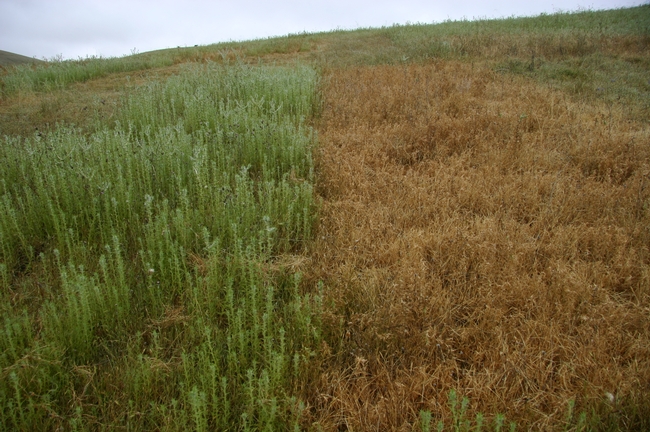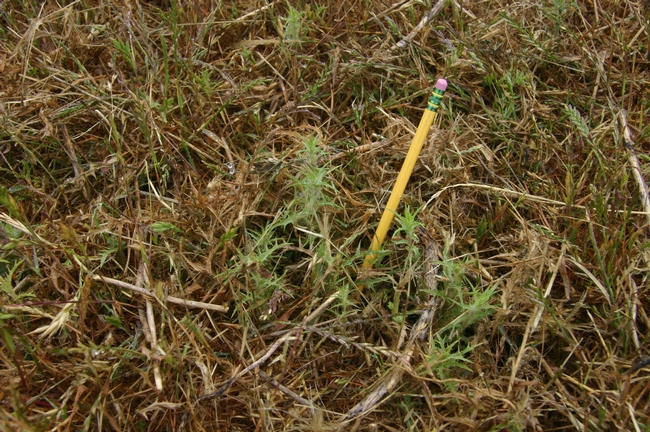Woolly distaff thistle is a persistent problem on rangeland in the northern Bay Area, especially on ranches that raise cattle for organic dairy or beef. Mowing for distaff control is impractical on many of the region's steep, rocky slopes, and the plants appear to regrow when mowed at typical heights of 4 inches or so. Prescribed fire may help suppress seed production but presents its own set of risks. Some ranches have been forced to give up organic certification in order to deal with this pest.
We were given samples of Suppress, a new organic-labelled contact herbicide, to test on woolly distaff thistle. This chemical is a fatty acid, basically a kind of soap, which weakens plant cell membranes so the plants lose water and desiccate. Some other contact herbicides, such as oils and acetic acid (vinegar), work in the same way.
Contact herbicides control only the plant parts to which they are applied; they don't translocate through the phloem to kill the root systems of perennial plants, and they don't have any soil residual. So they are most effective on small annuals without established root systems. The Suppress label specifically states that it is most effective on smaller plants.
Like other contact herbicides, Suppress is non-selective. This means that unlike chemicals such as Garlon (selectively controls broadleaf species) or Poast (controls grasses), Suppress will ‘burn' any green plant tissues it contacts. This is a problem for us, because a lot of the rangeland consists of plants we don't want to hurt, like forage grasses, legumes, and native species.
Fortunately, distaff thistle stays green and goes into flowering later than most of the desirable species. This means that we can apply a contact herbicide in late spring, after the grasses and other plants have dropped their seed and senesced, while distaff is still green and hasn't yet produced seed. This is the same timing window we have used for controlling other late-season plants, such as yellow starthistle, medusahead, and barb goatgrass, with prescribed burning. If seed production can be suppressed until the summer dry season sets in, then we will have prevented new seed production this year.
Unfortunately, distaff thistle is pretty large by late spring so we didn't know if Suppress would be effective.
We established trials at two locations in Marin and Sonoma counties to compare the effects of mowing to different rates of Suppress. The chemical was applied, per label, at 6% and 9% chemical in 50 and 100 gallons per acre of spray solution. Applications and mowing were done 26 May 2015, when grasses were senesced and distaff thistle was just starting to flower.
By 22 June, distaff thistle in mowed plots had regrown to some extent and was thinking about flowering again. Mow-only plots were mowed again 22 June, and mow-followed-by-Suppress plots were treated the same day (9% / 100 GPA).
Preliminary evaluation on 22 June produced the following impressions.
- Suppress was pretty good at controlling distaff thistle in the first application. 100 GPA applications were most effective, suggesting that thorough coverage is the most important parameter in using this chemical. There were still a few regrowing plants in most plots.

- Mowing significantly reduced flower head production, but many of the regrown stems were starting to flower while very short, probably below the height of a second mow.

Our hunch is that mowing followed by Suppress will be an effective integrated treatment. Suppress alone is not completely effective, because it's hard to get complete coverage of large plants in late spring. Mowing alone is not a solution, because the plants regrow below mowing height. However, an initial mowing removes most of the biomass, and a followup treatment with Suppress gets very good coverage of the regrowth. We'll know more at the next evaluation.
Photos by David Lewis, Marin County Cooperative Extension Director